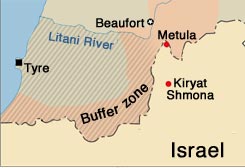 The Israeli government continues the debate over the shape of the proposed buffer zone in southern Lebanon, as well as the shape of the campaign against Hezbollah in Lebanon. Haaretz reports that Prime Minister Ehud Olmert and Defense Minister Amir Peretz are at odds over how deep the IDF should push into Lebanon. Peretz advocates all the way to the Litani River, while Olmert appears to support the current plan to maintain the 8 kilometer buffer zone.
The Israeli government continues the debate over the shape of the proposed buffer zone in southern Lebanon, as well as the shape of the campaign against Hezbollah in Lebanon. Haaretz reports that Prime Minister Ehud Olmert and Defense Minister Amir Peretz are at odds over how deep the IDF should push into Lebanon. Peretz advocates all the way to the Litani River, while Olmert appears to support the current plan to maintain the 8 kilometer buffer zone.
Prime Minister Ehud Olmert, however, is said to be reluctant about expanding Israel’s ground operation. While Peretz believes that the short-range rocket threat posed by Hezbollah can be neutralized by taking the area up to the Litani, Olmert feels that such a move would not be able to counter the longer-range missile threat posed by the Shi’ite organization… The expansion, which would include occupying the port city of Tyre, still requires the approval of the security cabinet, and could mean a further call-up of reservist soldiers… For now, the cabinet has approved the creation of a buffer zone some eight kilometers inside Lebanon which Olmert wants the military to control until an international peacekeeping force can be deployed in the area.
|
Southern Lebanon. Green indicates Israeli occupied town; red IDF warned towns of operations; yellow Israeli airstrikes; orange clashes. Click map to view. |
The city of Tyre has been a major point of origin for Hezbollah missile strikes into Israel. At the start of the operation against Hezbollah, the Israeli leadership signaled they were not interested in occupying Lebanese territory, other than a 1-2 kilometer buffer zone on the immediate border supported air patrols to suppress Hezbollah rocket positions. After the steady downpour of rockets into Israeli territory, including rocket launched from long range, and the surprise over Hezbollah’s military sophistication, the Israeli government became more aggressive and the plan evolved into the current, cabinet approved 8 kilometer buffer zone. This also includes aggressive air strikes outside of southern Lebanon: in the Hezbollah con trolled Bekaa Valley, southern Lebanon and elsewhere. A look at the current battle map and the map of the estimated shape of the future buffer zone shows the IDF is shaping their operations in Southern Lebanon to match the requirements of the 8 kilometer buffer zone.
The ground fight continues in southern Lebanon. Engagements have been reported in the southwestern village of Shama (the news from this region has been quiet since the conflict began), where the IDF killed 4 Hezbollah fighters; two IDF troops were killed by anti-tank fire in Markaba and another two were wounded in ground skirmishes in Al Tayyabah; and 1 Hezbollah was killed and another wounded during fighting in Mankala. Fifteen Hezbollah fighters are said to have been killed on Friday. Two Israelis were killed and over 50 wounded during Hezbollah rocket attacks on civilian population centers. Over 130 rockets were fired on Friday, and 70 rockets were launched within a timespan of 1 hour, indicating Hezbollah still possesses command, control and communications to launch a coordinated barrage of rockets.
The limitations to the current plan, which precludes a move in to the Bekaa valley are highlighted by the New York Sun. “The Israel Defense Forces also says it has not been able to seal the border between Syria and Lebanon, making it possible to ferry men, small rockets, and other material to Hezbollah through the back roads and smuggling routes in the Bekaa Valley,” reports the Sun. And Iran is said to be rushing in military aid to resupply Hezbollah prior to any cease fire.
Israel will not be able to seal the border along the Bekaa Valley region via air power alone. The Israeli Air Force may be able to catch missile resupply convoys, but will inevitably kill civilians crossing the border. Such an event happened today when 27 Syrian Kurd farm workers were killed during an IAF airstrike outside of the Qaa border crossing in northern Lebanon. Although the deaths of the farm workers were accidental and such events occur in a war zone, incidents such as this and Qana will bring increasing media and international pressure to force a cease fire.









3 Comments
Israeli Cabinet Continues Debate Over Ground Campaign
Courtesy of the Counterterrorism Blog:
By Bill Roggio
The Israeli government continues the debate over the shape of the proposed buffer zone in southern Lebanon, as well as the shape of the campaign against Hezbollah in Lebanon. Haaretz reports that…
Diplomacy and the Hounds of Hell, Part XVIII
The Israeli war against Hizbullah continues, with Israel striking targets throughout Lebanon and Israeli ground forces continue to move towards the Litani River. Targets were hit in Beirut, which puts Nasrallah in a most curious position. He was busy…
Roundup
Because I am too lame to write 30 individual posts.